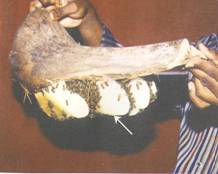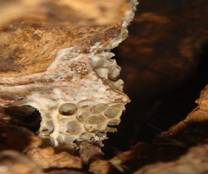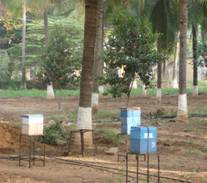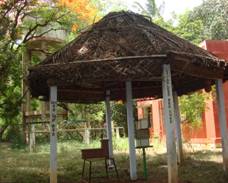HOW TO ACQUIRE AND HIVE BEES?
1. When there is a colony on a wall or in the hollow of a tree……..
To locate the colonies in the walls or tree hollows, observe such likely places in bright sunny mornings when the bees will be busy going in and out of the hollows. A few whiffs of smoke are first blown into the hollow with the aid of a smoker and the bees get quietened. Then the entrance to the colony is cut sufficiently wide. The comb is removed wholesale with maximum number of bees adhering to it. The combs having plenty of worker brood are selected, carefully cut to suit the size of the frames and fixed on to the frames by means of a banana fibre and the frames immediately kept inside the hive. A few combs with pollen and honey may also be taken and kept at the sides of the hive; this, will supply necessary food to the bees till they get accustomed to the new surroundings and collect food materials themselves.
The queen should be traced and along with a few workers trapped inside a glass tube, a match box or any other small container which is kept over the frames of the hive. The workers, having been deprived of their original home, move about in search of their queen. A few spot her inside the container and communicate the message to other bees which now come and settle in the brood combs. Now an empty super without frames is kept over the brood chamber and the queen and workers are released from the container. They move into the brood chamber, when the super is taken away and the roof kept over the brood chamber. If the hive with the new colony is to be necessarily shifted to some other place, the entrance slit is plugged with a wire gauge and the hive transported in an evening.
In the above process the queen may sometimes escape detection. In such cases, the workers invariably rear a new queen from the existing fertilized eggs either after transferring a few such eggs to specially constructed queen cell or by widening the regular brood cells.
2. By use of decay hives
The decoy hive consists of a piece of hollowed out Palmyra trunk with both ends closed with planks and provided with a number of holes in one of the planks to permit entry and exit of bees. A mud pot can also be used in place of Palmyra trunk. The inner surface of the receptacle is smeared with bees wax. It is kept in a tree branch etc during swarming seasons. It is eventually occupied by a swarm and combs are constructed in a few weeks time. The tenanted receptacle is removed. One of the sides opened and the colony transferred to an one of the artificial hive. The hiving should be done in good breeding seasons.
 |

|
Hive under coconut palm leaf |
Decoy hive |
3. Hiving a swarm
When a swarm is readily available, it can be more advantageously hived by this method rather than through a decoy hive. The hiving can he preferably done in an evening, if immediate hiving is not possible it is better to leave it after spraying with a thin sugar syrup lightly over the bees. Three to five frames with comb foundation sheets are put in a hive; a frame with capped cells containing pollen and honey without any bee taken from any other hive should also be given if possible. The swarm is then smoked and the bees are collected in a box or basket by shaking the branch or twig containing the swarm. First a handful of bees are put in the empty side of the hive and the rest dumped over a slanting board kept at the entrance. If one or two bees are pushed in through the entrance with a finger, others will follow. It should be ensured that the queen enters the hive
Location of an apiary
Often a beekeeper is left with no choice for location of his hives, say, when he intends to keep them in his backyard or a small home garden. But where a selection among many possible sites can be exercised, the following points require consideration.
- An apiary should be located where there is abundance of nectar and pollen-yielding plants within the radius of about 1 to 1½ km.
- The site should not be exposed to strong winds or, at least the hives should not face the direction of the prevailing winds. Trees, bushes or trellis work may be provided to make the site windy.
- The site should be flat but with good drainage facilities
- Clean and fresh running water should be available to the bees in or near the
- A young orchard is an ideal choice. But thick groves may be avoided because the air becomes stagnant and during summer the atmosphere is close and muggy.
- If the site is shade less and exposed, an artificial shed may be provided for
- An apiary should not be located too near a highway.
- A good barbed-wire fence or a live – hedge may be provided to keep out intruders.
- The site should be free from termite and black ant infestations.
About 50 to 100 colonies may be kept in an apiary according to availability of space. They may be placed 2 to 3 meters apart in rows spaced from 3 to 7 meters apart. In large apiaries too much uniformity in the placement is not good. Land marks such as trees, bushes etc., may be planted at suitable intervals to help the bees to recognize their hives.

|

|
Under coconut plantation |
Under thatched roof |
|




